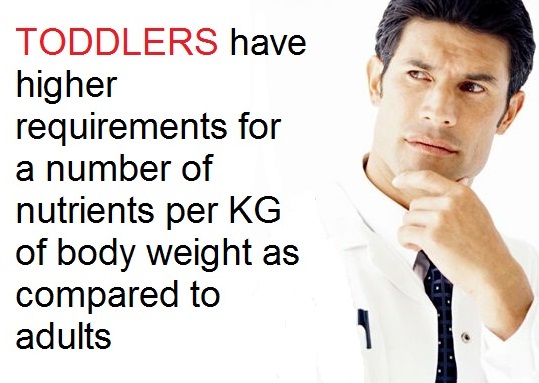Toddler nutrition (Iron)
Toddlers’ (1-3 years of age) have nutritional requirements which differ quite markedly from those of older children and adults.
This is result of:
●High growth rates
● Rapid developmental changes
● significantly increased level of physical activity Toddlers have higher requirement per kg of body weight, for a number of nutrients, such as vitamins and minerals.
To meet those higher requirements a balance diet in toddlers is very important.
TODDLERS have higher requirements for a number of nutrients per KG of body weight as compared to adults
Due to this rapid developmental phase, a toddler has different nutritional needs compared to an adult
Between the age of 1 and 3, toddlers have high requirements for many nutrients compared to adults3, 4

Dietary and nutritional problems in infants & toddlers
●The prevalence figures of iron deficiency anemia in the Eastern Mediterranean Region vary from a low of 17% to a high of over 70% among preschool children.5
● Low intakes of vitamin D and iodine in toddlers
●Higher than recommended intakes and sodium
●These problems are associated with:
– Early introduction/ excessive intakes of cow’s milk/dairy foods
– Low intakes of fruits and vegetables
Iron
Iron, is
● An important trace mineral which performs many vital roles in the body,
● Essential to most life forms and to normal human physiology,
● An integral part of many proteins and enzymes that maintain good health,
● An essential component of proteins involved in oxygen transport,
● Essential for the regulation of cell growth and differentiation.
Iron in the body is found in
● haemoglobin, the protein in red blood cells that carries oxygen to tissues, and which stores almost two thirds of the amount of iron,
●myoglobin, a protein that helps supply oxygen to muscle, and in enzymes that assist biochemical reactions,
● Proteins that store iron for future needs and that transport iron in blood. Iron stores are regulated by intestinal iron absorption.
Iron Deficiency
● The World Health Organization considers iron deficiency the number one nutritional disorder in the world.
● As many as 80% of the world’s population may be iron deficient, while 30% may have iron deficiency anemia.
● it develops gradually and usually begins with a negative iron balance, when iron intake does not meet the daily need for dietary iron.
● Iron-deficiency anemia persists as one of the most common health problems worldwide, a condition that affects approximately 20-25% of the world’s infants.6
● It limits oxygen delivery to cells, resulting in fatigue, poor work performance, and decreased immunity.
●During infancy iron-deficiency anemia is associated with morbidity, impaired growth, and decreased behaviour and psychomotor development.5
● chronic iron deficiency in infancy identifies children with poorer cognitive function and lower scores in school achievement tests, suggesting that irreversible abnormalities result from a deficiency at a critical period of growth and differentiation of the brain.7
● the association between iron deficiency anemia and diminished mental, motor, and behavioural functioning is well established, and these effects appear to be long-lasting despite correction of the iron deficiency.5, 8
Long term effects of IDA (Iron deficiency anemia):
There is evidence to suggest that the adverse effects of the iron deficiency anaemia on the psychomotor development may not be fully reversible even when treatment is applied.
Iron Deficiency Anemia can be attributed to
●Early introduction of cow’s milk in the first year of life is the greatest nutritional
●Over-use of unmodified cows’ milk with toddlers.5
● A diet that contains a low level of iron of good bioavailability.5

